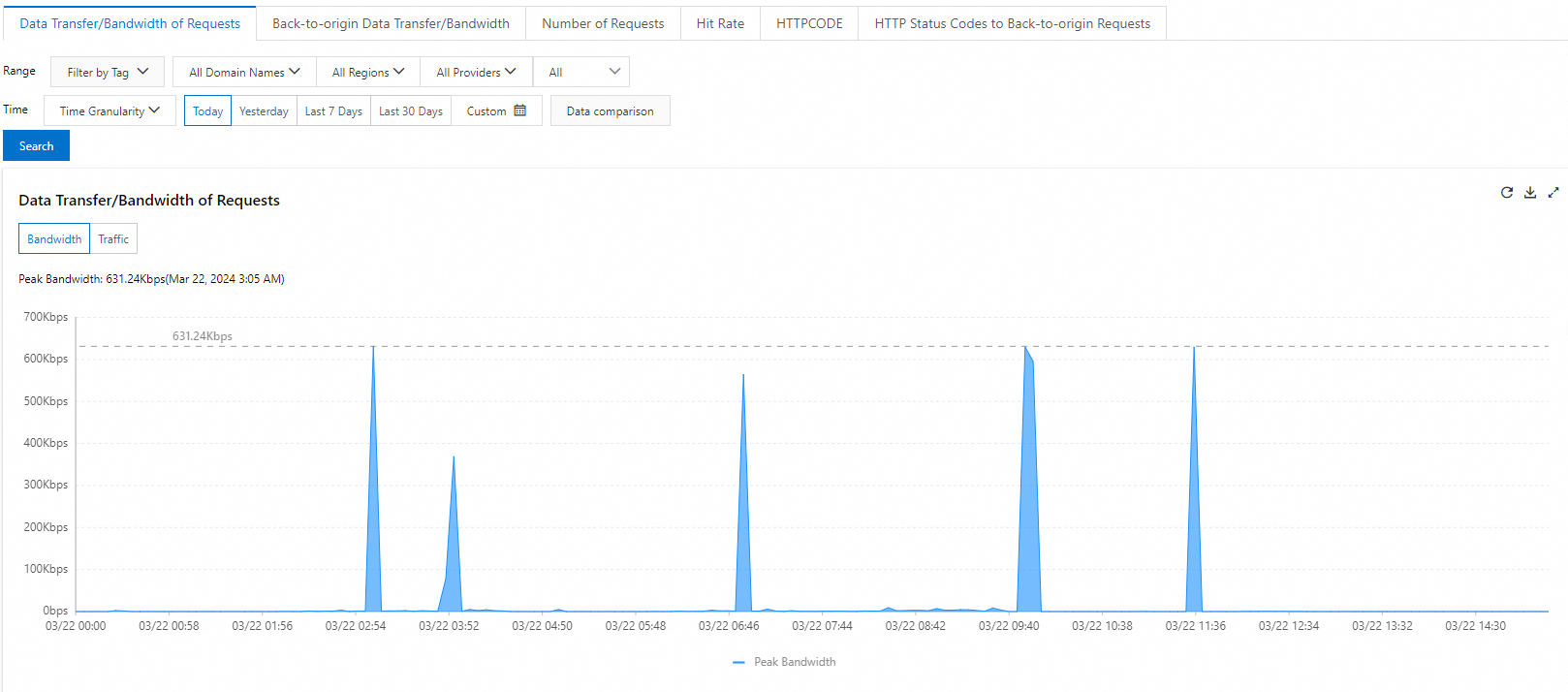The resource monitoring feature collects data including network traffic, bandwidth, the number of requests, cache hit ratio, and HTTP status codes based on the region and Internet service provider (ISP) of client IP addresses. You can make informed business decisions and optimize Alibaba Cloud CDN resource management based on the collected monitoring data.
Overview
Compared with real-time monitoring, resource monitoring supports a longer maximum time range per query and a longer time period within which historical data is available.
Time granularity
You can query resource monitoring data by using the Alibaba Cloud CDN console or API. However, the maximum time range per query and the time period within which historical data is available are different. The following table describes the maximum time range to query, the period within which historical data is available, and the data delay.
Use the console
Time granularity
Maximum time range per query
Historical data available
Data delay
5 minutes
3 days
90 days
15 minutes
1 hour
31 days
90 days
4 hours
1 day
90 days
90 days
04:00 on the next day
Use the API
Time granularity
Maximum time range per query
Historical data available
Data delay
5 minutes
3 days
93 days
15 minutes
1 hour
31 days
186 days
4 hours
1 day
366 days
366 days
04:00 on the next day
Monitoring items and metrics
The following table describes the resource monitoring items. You can specify filter conditions, such as accelerated domain names, regions, and ISPs. You can also export monitoring data for further analysis.
In terms of resource monitoring, data is collected based on the region and ISP of client IP addresses. In terms of metering, fees are calculated based on the network traffic, bandwidth, and number of requests on Alibaba Cloud CDN points of presence (POPs) in each billable region. The resource monitoring data and the billing data may be slightly different due to different collection methods. The line chart of resource monitoring displays the change of bandwidth usage. For more information about the metering data in bills, see Resource usage overview.
Data is collected and calculated by calling API operations. For more information, see the API references in the following table.
Monitoring item | Description | API operation |
Data Transfer/Bandwidth of Requests | Monitors the bandwidth and network traffic of accelerated domain names. You can query monitoring data by region, ISP, and protocol. The following protocols are supported: HTTP, HTTPS, QUIC, IPv4, and IPv6. | |
Back-to-origin Data Transfer/Bandwidth | Monitors the origin bandwidth and traffic of accelerated domain names. | |
Number of Requests | Monitors the number of requests and queries per second (QPS) of accelerated domain names. You can query monitoring data by region, ISP, and protocol. The following protocols are supported: HTTP, HTTPS, QUIC, IPv4, and IPv6. Note
| |
Hit Rate | Monitors the byte hit ratios and request hit ratios of accelerated domain names. | |
HTTPCODE | Monitors the HTTP status codes returned from POPs. The HTTP status codes include 2xx, 3xx, 4xx, and 5xx. | |
HTTP Status Codes to Back-to-origin Requests | Monitors the HTTP status codes, including 2xx, 3xx, 4xx, and 5xx, returned from origin servers. |
Usage notes
The traffic usage of accelerated domain names that is queried by using the monitoring or resource usage feature available in the Alibaba Cloud CDN or DCDN console or by calling API operations differs from that collected in logs. Typically, the traffic usage of accelerated domain names that is queried by using the monitoring or resource usage feature is 1.1 times that collected in logs. For more information, see Why is the traffic amount found by using the monitoring and usage analytics feature or the usage statistics feature different from the traffic amount that is logged?
Differences among resource usage query, resource monitoring, and real-time monitoring
Resource usage query: Usage data is collected by POP. You can query resource usage data based on the billable region where the POP belongs to, such as the Chinese mainland, Asia Pacific 1, and North America. For more information, see Query resource usage.
Resource monitoring and real-time monitoring: Monitoring data is collected based on client IP addresses. Each client IP address belongs to a region or an ISP. You can query monitoring data by region, ISP, or both. For more information, see Resource monitoring and Real-time monitoring.
Differences between resource monitoring and real-time monitoring
Minimum data delay: Real-time monitoring has a lower data delay. The data delay for real-time monitoring is about 5 minutes with the query granularity of 1 minute, while the data delay for resource monitoring is about 15 minutes with the query granularity of 5 minutes.
Minimum data granularity: Real-time monitoring supports smaller granularity. The minimum data query granularity for real-time monitoring is 1 minute, while the minimum data query granularity for resource monitoring is 5 minutes.
Query by protocol: Resource monitoring supports more protocols. Resource monitoring supports data query by HTTP, HTTPS, QUIC, IPv4, and IPv6, while real-time monitoring does not.
Procedure
Log on to the Alibaba Cloud CDN console.
In the left-side navigation pane, choose .
On the Resource Monitoring page, select the monitoring item that you want to query and filter conditions, and click Search.
The system displays monitoring data based on the specified item and filter conditions. Then, you can analyze data online or export the data to your local PC for analysis.
